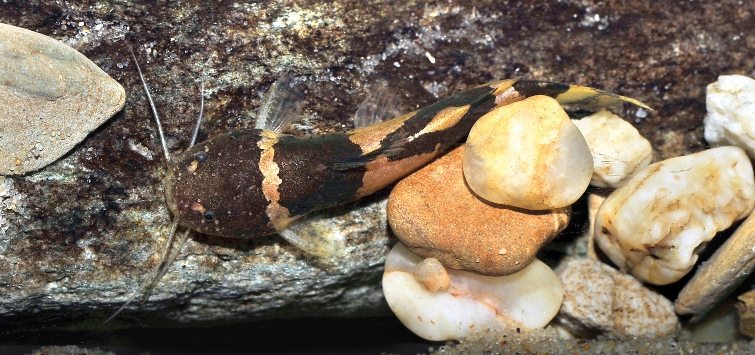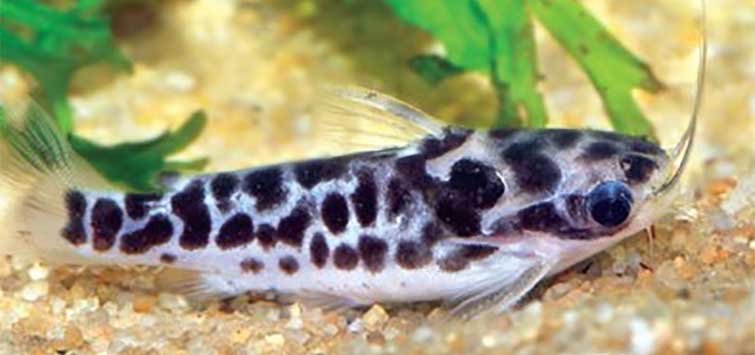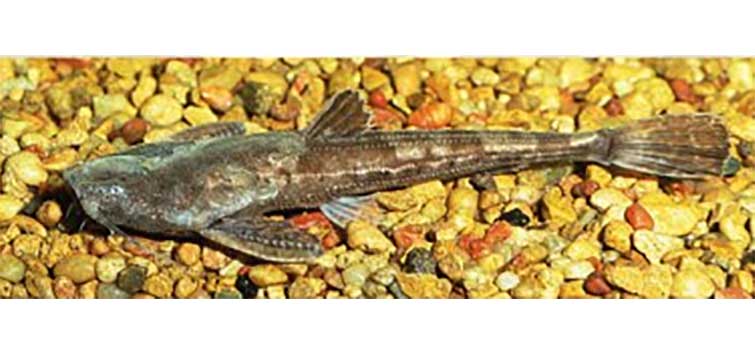The Buzz on Breeding Bumblebee Catfish
Author: Rebecca Goldring
I never intended to own bumblebee catfish (Microglanis spp.), let alone spawn them. It was sheer dumb luck, and good fish friends, that landed me with a small group of them in July of 2021.
I responded to an offer of dwarf hoplo cats posted on a local club forum. When I arrived to pick up my purchase, I found that the seller had, quite generously, thrown the bumblebees in with the hoplos. I wasn’t expecting them and didn’t have a set place to put them, but they were adorable and, thankfully, full grown at 2 to 3 inches (5 to 7.5 cm).
I got them home and did something I very rarely do—I added them to a community tank. Normally I quarantine things, but the trip to pick them up took longer than anticipated, in part due to their delightful keeper and his gorgeous aquariums, and I arrived home exhausted and late for dinner. I had not planned to quarantine as many fish as I came home with, so the bumblebees went into a tank with rock piles, sand, driftwood, and many plants. I realized, belatedly, that I hadn’t even thought to count them before releasing them, and I felt nearly certain I’d never see them again.
Three weeks later, I was on my own with my kids while my husband took a rare trip into the office. This meant leaving my basement office to make the kids lunch, and I happened to be upstairs and walking past the tank when I noticed a flurry of activity. On closer inspection, two of the bumblebee catfish were racing around the tank, a skinny male chasing an absurdly plump female. Alas, the kids were hangry, and I made note to check on the fish’s behavior after lunch.
I found the chase ongoing when I returned to the tank later. As I watched, I saw what looked almost like grains of coarse sand fall through the plants into a pile of large river rocks as the fish passed through and around the plants and the rock crevices that held them. I had work to do and could not stay and watch for long, but I remembered to check back later that evening.
The First Spawn

On initial inspection, I found no eggs (not surprising in a community tank), but then I thought, “I saw the eggs fall through plants and into the rocks.” I took out a pipette and used it to blast water between some rocks. Sure enough, small (1 to 2 mm), transparent green eggs popped up out of the crevices. I used the pipette to gather as many as I could and placed them in a breeder box.
By late that night, I could see tiny embryos starting to stir within about half of the eggs I’d placed in the box. As I often do, I shared some photos on social media. These were of the eggs with the news that the bumblebee catfish had spawned. This caused a different kind of stir. I have plenty of fish friends, and it seemed that the spawn and images of eggs were pretty exciting to at least a few of them. Folks wanted to know what I had done, what I had fed, my water source, my lighting…
The most I could tell anyone was “nothing special.” I just happened to be in the right place at the right time to catch them in action. The tank had gone about a month without a water change, the temperature held at around 78°F (25°C), and my relatively hard tap water and forgetful feeding schedule hardly seemed conducive to a spawn. I could only conclude that these fish probably spawn pretty frequently in captivity, but we just don’t catch them doing it.
The eggs that appeared fertile hatched about 24 hours after spawning, and the fry behaved much like tetra fry, darting about whenever I shined a light on them. After another two to three days, they seemed to have absorbed their yolk sacs and had sprouted tiny whiskers, and I began offering some fry foods.
Despite my best efforts, though, fry kept disappearing. I thought they must be dying and decaying very quickly. Those that remained swam, constantly, up and down the sides of the breeder box. I finally understood where they were all going when I watched one swim up, into, and out of the uplift tube on the breeder box. I tried to move the few remaining fry, but none from that original group survived.
Try, Try Again
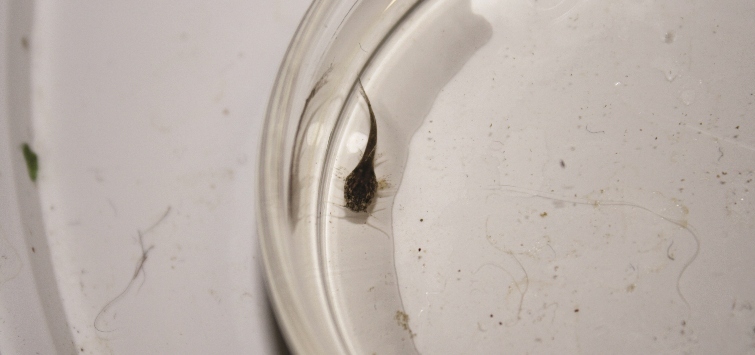
For the next month or so, I checked the tank every afternoon, hoping to catch the adults racing around like I’d seen before. Occasionally, I’d use the pipette to check between rocks, just in case, but I found no additional eggs. I realized that, if I wanted to raise fry, I’d need to remove the adults to a separate tank. This took several additional weeks, since I had no desire to tear down the entire tank.
At long last, I had most, if not all, of the adult fish. From the looks of it, I had five Microglanis bumblebees, three males and two females. This solved part of the problem, but I still needed to figure out how to collect eggs.
Luckily, this second part didn’t take much imagination. In addition to breeding a variety of cichlids and catfishes, I’ve spent the past few years just a little bit obsessed with spawning tetras (yes, I know—I’m a masochist). I knew right away that I wanted to use the same kind of “false bottom” or mesh setup that I use for other non-adhesive-egg-scattering fish, but I didn’t know how I’d do that while replicating the river rock and boulder piles the fish seemed so attracted to in their previous spawn. Rocks would weigh down mesh, and large rocks on a bare bottom could easily crack a tank.
Eventually I settled on a very “high-end” design consisting of PVC pipe, egg crate, plastic mesh, and zip ties. I sized the egg crate to tightly cover the bottom of the breeding tank and trimmed plastic mesh to cover that to the edges, using zip ties to secure it. I then used zip ties to add lengths of PVC pipe so that the mesh bottom would stay elevated off the bottom of the tank and the weight from rocks would still be distributed.
Lastly, I covered this false bottom in marbles “borrowed” from my son and added some softball-sized river rocks in clusters on either side of the tank. In addition to ensuring that the fish didn’t scratch their soft bellies on rough mesh, the marbles also helped close any gaps around the edges of the mesh and ensured that adult fish wouldn’t find their way under the false bottom.
It didn’t take long for the fish to get busy in this setting. I walked into my fish room during my lunch break a week or two later and found both females racing around the tank with males in hot pursuit.
Try as I might to get photos, adults move so quickly that even videos prove difficult.
A few hours later, the bottom of the tank was littered with eggs, which started hatching within 18 hours. Not wanting to have to catch the adults again, I left them, thinking that fry would likely stay beneath the false bottom and could easily flee there if pursued. Unfortunately, this was overly optimistic. Within a month, all of the fry had disappeared.
I kept hoping for another spawn, but more than a month passed with nothing. I tried water changes with tap and RO water, different frozen and prepared foods, live blackworms, and lighting changes. One day, I noticed that one of the male fish had managed to squeeze himself through a crack and make his way beneath the false bottom. I was transitioning to a new job and had some time off, so I took the opportunity to catch out all adult fish, confirm that no fry remained, vacuum up the mulm from the bottom glass, and rearrange all of the rockwork before putting them back.
Success at Last!
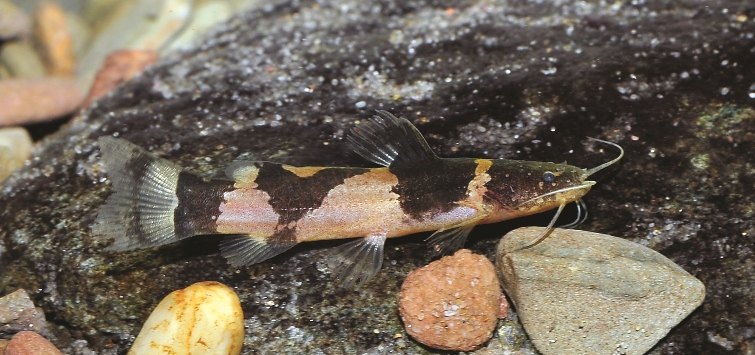
As luck would have it, bumblebee catfish breeding occurred again sometime during my first day at my new job. I didn’t notice the eggs but caught sight of newly hatched fry darting about in the beam of a flashlight on my second day. I knew that I needed to remove the adults this time. Still, it took me a few days to get around to it. Once I’d removed the adults, all of the rocks, and the false bottom, I went about using a turkey baster to collect as many fry as I could and put them into a breeding tank so I could more easily feed and observe them.
In the three weeks since hatching, the fry have grown and flourished. Most are about half an inch (just over 1 cm), and they swim constantly (and quickly!). While they tend to seek shelter, I’ve noticed they favor having it near the water’s surface instead of under items at the bottom of the tank, and they seem drawn to light (unlike tetra fry).
I prefer to feed the fry either baby brine shrimp or decapsulated brine shrimp eggs because this turns their bellies bright orange. Orange bellies are a sure sign that the young fry are eating well. They do accept other foods, such as microworms, vinegar eels, frozen baby brine shrimp, and prepared fry foods. I’ve also released the fry from the breeding tank in the past week because it started to look overpopulated as they gained size.
Takeaways
Across three bumblebee catfish breeding events, the only “triggers” I’ve observed in these fish are changes in the physical environment/hardscape and the presence of a well-rounded female. The first spawn I observed took place not long after they’d settled into a new tank in a new house. The second was not long after they’d settled into the spawning setup I assembled. This most recent spawn took place just a few days after the fish were removed to a specimen cup for an hour or so and the rockwork was completely rearranged.
All three spawns occurred in tanks that were filled with tap water, had a pH between 6.5 and 7.8, and were furnished with clusters of softball-sized river rocks with Anubias or other plants wedged between them. If I had to make a just barely educated guess, I would say that these fish spawn away from their immediate territories and move on pretty quickly.
They seem to have an excellent sense of smell and to be rather effective predators, as evidenced by how quickly they manage to devour their own fry once they start to come off the bottom of the tank. In all three spawns, eggs have hatched in under 24 hours, and hatch time seems to be negatively correlated with temperature.
I’m optimistic that I’ll have a good number of the several dozen current fry make it to adulthood. Ultimately, I can’t attribute my success in breeding these fish to any one factor outside of the coronavirus pandemic and dumb luck. Pre-COVID-19, I spent my days in the office and away from my aquariums. On the rare occasions I did work from home, my kids were almost always at school or camp, not at home asking for lunch. The pandemic put me in a situation where I was in the right place at the right time to observe something wonderful.
An Unexpected & Rewarding Experience
Although I never intended to keep bumblebee catfish, and certainly didn’t set out to breed them, I’ve found the experience educational and rewarding. Sometimes, no matter how much time we spend observing our fish, we still need a change in perspective to understand them.
Had I not witnessed the bumblebee catfish breeding activity myself, I would not have expected to collect, hatch, and rear catfish eggs in the same way I collect, hatch, and rear tetra eggs. I hope that my experience might give others a starting point in spawning and understanding reproductive behaviors in these and similar species and to see more complete observations of the spawning behavior and development of Microglanis species in the years to come.

.png?h=595&iar=0&w=2781&hash=5FD5E69473BCC22199FBFA2FB71B6033)
